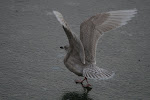
(Photo: Chris Bridge)
Spring is on its way so anything ornithological based is all systems go! Ringing is certainly one of these affected as everything is on the move so migrants are being picked up and wintering birds are providing their last opportunities to be caught. I thought SCAN had finished for the winter, but an email from Steve
Dodd alerted me that there was one last catch that would be attempted on the 12
th March. Arriving
on site, Steve realised that the tide would be too low and we would have a good chance of catching nothing so it was postponed to the following weekend.
Arriving
on site at 07.30 with Chris, Kane and
Hamza, we were eager to set up the nets due to a fabulous count the previous day of 160
Sanderling and 40+
Turnstone.
Sanderling in North Wales certainly aren't common!
We fired one of the nets at 10.30 after Chris and Robin
Sandham managed to twinkle
Sanderling down the beach into the catching area and I managed to lift the
Turnstone roosting on the River
Clwyd to the catching area.

(Photo: Chris Bridge)
Superbly we caught an impressive 114 birds with totals being 61
Sanderling (3
juv), 17
Dunlin (all
juv) and 36
Turnstone (4 recap).
Once all birds had been extracted, it was time to ring and process all the birds. Robin and I ringed all the
Sanderling and
Dunling, plus 20 of the
Turnstone, with Steve scribing age and ring. The processing team consisted of Rachel measuring wing (plus tarsus and foot of
Sanderling), Kane doing head and bill, and Chris weighing. All of which was expertly scribed by Kelvin Jones.

I wasn't expecting to catch any
Dunlin as we were only targeting
Sanderling and
Turnstone. It was nice to be able to hold one of my favourite birds again and also compare them to
Sanderling side by side (
apologies for no pictures of this!)


(Photo: Chris Bridge)
There real reason for this catch was to target an individual
Turnstone which had been seen in the previous weeks carrying a Norwegian ring, but the whole code wasn't read in the field. One of the last birds we extracted had a ring on it's tarsus (unusual for
Turnstone (we do them above the knee)) and low and behold, we had caught the target bird...RESULT! I will post details on this bird in due course when data is received.
I decided that it may be a large catch the night before (somewhat optimistically I'll
admit!) so I thought I would leave my cameras back in Bangor and concentrate on the ringing of the birds. This was for several reasons, but mainly because when I'm concentrating on photographing birds, I don't actually look at them which is bad! This allowed me to sit in with the processing team and measure the head and bill of
Turnstone which was a new experience and something I really enjoyed once I got into a rhythm.
Overall I have nothing but positives about
today's catch as everything went to plan and I got to handle some wonderful species and again got the hang of different ring sizes. Thanks to everyone who attended for a truly amazing day, and specific thanks to
Hamza for the lift, and Steve for the invite!
 I am not having the best of luck in 2011 when it comes to twitching birds. I have failed to see the Bonaparte's Gull twice and today I failed to relocate the Firecrest in Holyhead found this morning by Ken Croft. The strong winds currently barrakading its way through North Wales has clearly done something in terms of migration. Onsite I picked up 4 singing Blackcap, 10+ singing Chiffchaff and best of best of all were my first 3 Willow Warblers of the year. There were plenty of Goldfinch singing onsite and Ken Croft showed me a very confiding Water Rail which is the last remaining bird of the 4 that wintered.
I am not having the best of luck in 2011 when it comes to twitching birds. I have failed to see the Bonaparte's Gull twice and today I failed to relocate the Firecrest in Holyhead found this morning by Ken Croft. The strong winds currently barrakading its way through North Wales has clearly done something in terms of migration. Onsite I picked up 4 singing Blackcap, 10+ singing Chiffchaff and best of best of all were my first 3 Willow Warblers of the year. There were plenty of Goldfinch singing onsite and Ken Croft showed me a very confiding Water Rail which is the last remaining bird of the 4 that wintered. 
















































